The Great War project
As with all towns, cities and villages, the Great War had a lasting influence on the people of Kenilworth. Over 800 townsfolk from a population of about 6,000 joined the forces; but perhaps that number also arrived in town to work in the Coventry munitions factories. Many lived in tiny 2-up 2-down terraced houses.
Of the 800 regular soldiers, volunteers and conscripts that crossed the channel to fight in the trenches, sailed in the navy or flew in the Royal Flying Corps, over 130 never made it back home. Those that did found a housing shortage; a new estate of mostly 2 or 3 bedroom semi-detached houses was built just for them, changing the way the town developed in the 20th century.
But it is the deeds and sacrifices of Kenilworth’s citizens that rightly takes pride of place when the Great War, a war supposedly to end all wars, is remembered.
Sue Tall, the co-author with Betty Sunley of ‘Kenilworth and the Great War’, is the unequalled researcher of Kenilworth’s Great War combatants, of those who died or survived, and with my own knowledge of wider aspects of local history, we teamed up for a project to take the subject to a wider audience.
We created a walk to pass by the homes of some particularly interesting people involved in the conflict and this led to the production of a free leaflet, financially supported by Warwick District Council and designed by David Tall, and the enthusiastic help of Year 5 at Clinton School who were initially ‘guinea pigs’ for the tour but then provided the illustrations for the leaflet.
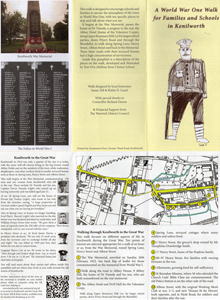 |
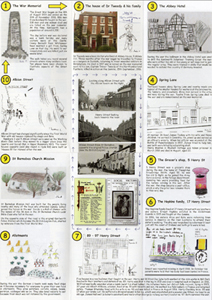 |
The leaflet is A3 in size and is aimed at families and schools but is suitable for all, and is packed with information. It takes you on a tour from the War Memorial, via Abbey Hill, Priory Road, Spring Lane, Henry Street, St Barnabas, Albion Street and terminates in Upper Rosemary Hill. As you pass the houses, it tells you the contribution of some of the townsfolk and their roles in the war, including many who died.
Sue and I conducted two ‘Walk Talks’ based upon the leaflet, accompanied by a WW1 re-enactor, for the ‘Heritage open days’ weekend in 2014 on which we expanded upon the lives of many who were lost, and the contribution of others, whilst outside the houses in which they lived. This led to a number of private groups, such as history societies, making bookings, and again in 2015 we conducted a public tour for the ‘Heritage Weekend’ event.
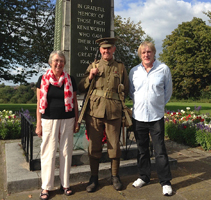
The leaflet is available, while stocks last, via the email link on the home page of this website, at ‘Kenilworth Books’ in Talisman Square, and The Library.
Further developments, 2017:
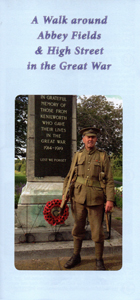 |
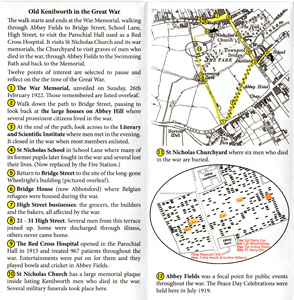 |
Three pages from the new 12 page leaflet
In 2017, Sue Tall and I produced a second Great War walk leaflet, covering the eastern half of the Abbey Fields and its perimeter roads. This of course includes the Parochial Hall (a Red Cross hospital in the war) and visiting the churchyard, the final resting place of a number of Kenilworth’s fallen. The leaflet can be found at Kenilworth Library and Kenilworth Books amongst other places; please contact me via the email address on the home page if you have any difficulty in locating a copy, or of course if you wish to stock copies.
In conjunction with the leaflet, we also successfully carried out the new war walk on 9th September 2017, and hope to repeat this in 2018, which will probably bring the curtain down on our project.
The free leaflets are available at Kenilworth Books and Kenilworth Library, or through this website.
We ask those who follow the routes to be considerate of the residents who live along them, and not to become intrusive.
Post script, October 2018:
After many successful walks of both routes, and with the centenary of the war’s end, Sue and I decided to end our annual War Walks. Our thanks to Malcolm, our re-enactor, the St Nicholas Church Warden’s and their helpers, and those who assisted at St Barnabas for all their help. And of course to the hundreds of members of the public who walked with us.